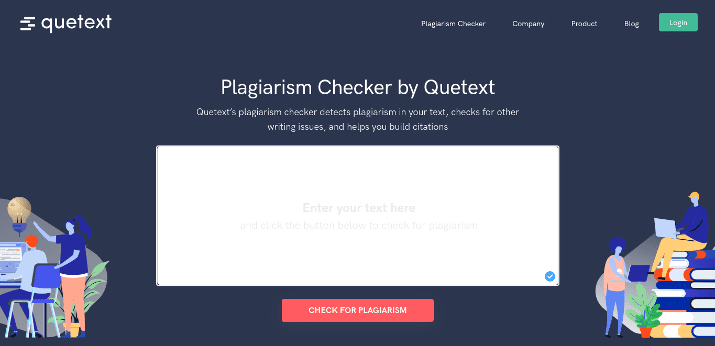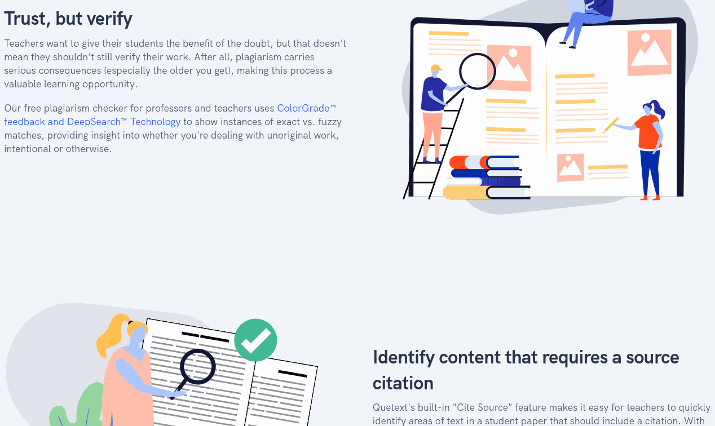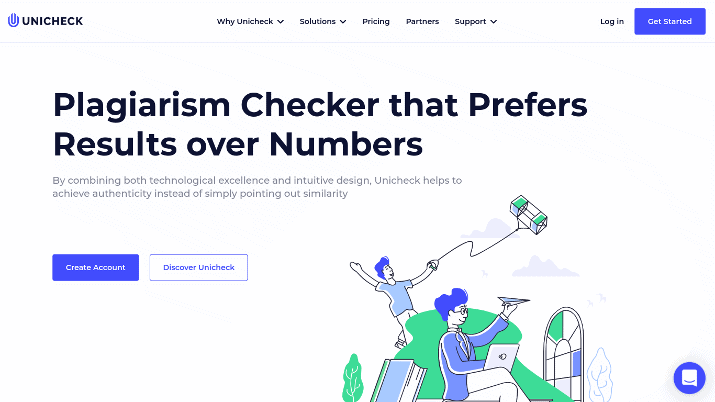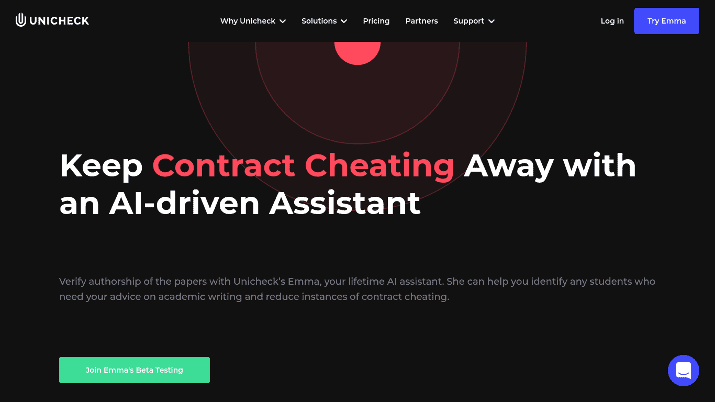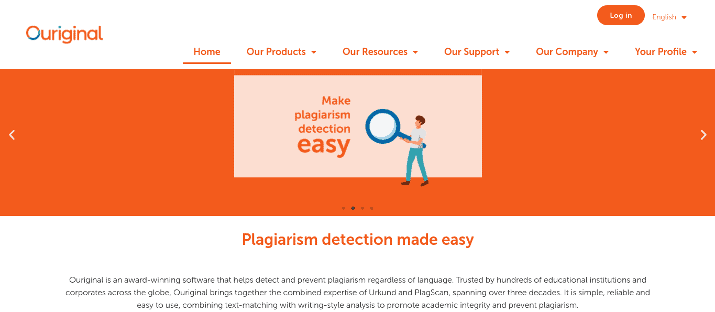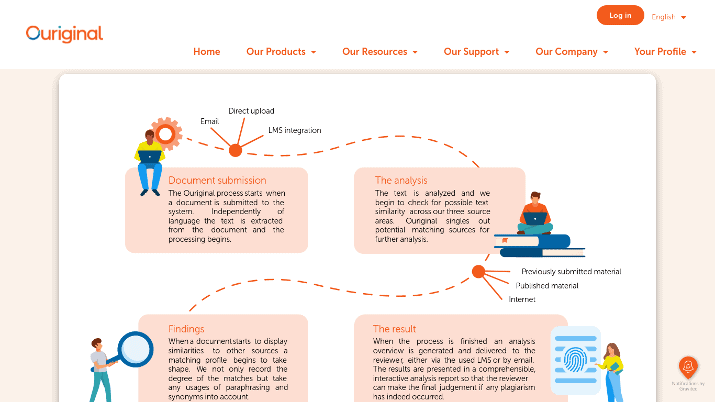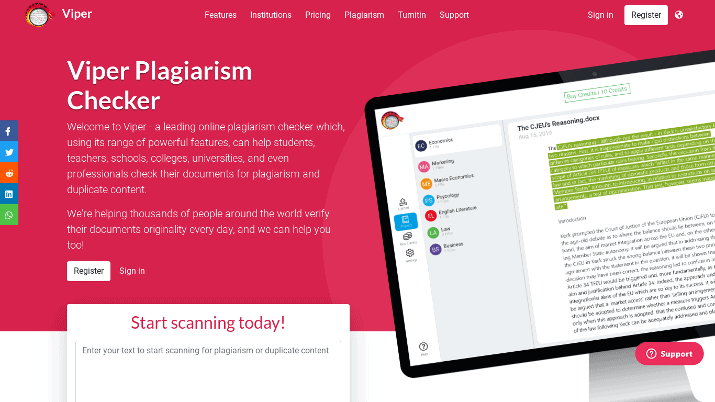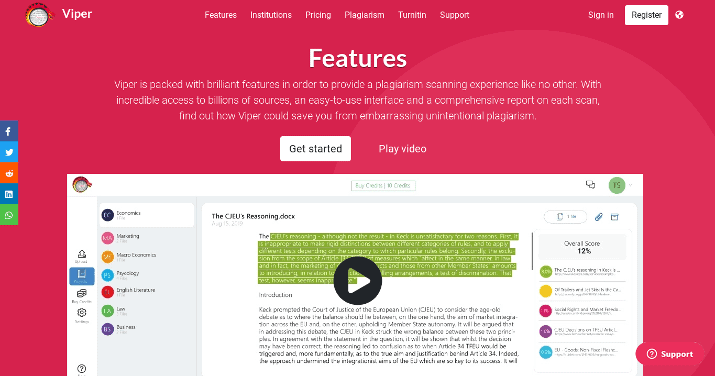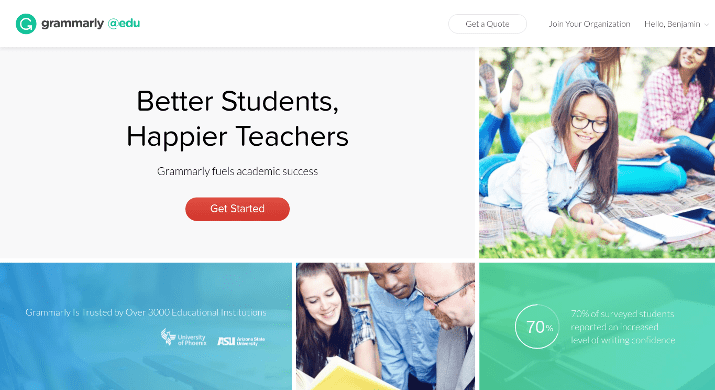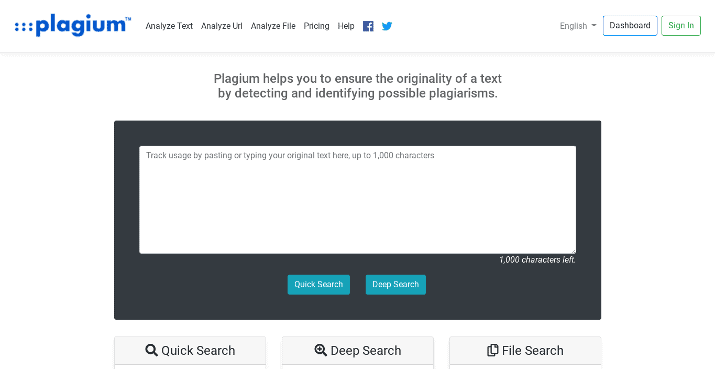Turnitin is a plagiarism checker for educators and students. It allows teachers to check their students’ submissions for plagiarism and copied text, assigning a Similarity Score based on how much of the text matches content in the Turnitin database.
However, one of the main problems people seem to have when using Turnitin is that it often has technical issues. As you can read in the reviews on the Turnitin Facebook page, many people complain of bugs, website outages, and other technical issues that interfere with productivity.
Furthermore, Turnitin seems to often highlight single words that are used naturally in a paper and flag them as “copied.” This can sometimes hinder the ability of professors to accurately determine when a student has committed real plagiarism.
Not only that, but Turnitin’s “Similarity Score” only gives a partial picture, and professors must look at the “Similarity Report” to see if a paper contains plagiarism or not. The concern is that many professors don’t bother looking at the Similarity Report, rejecting all papers that have a high Similarity Score, even when quotes flagged were properly cited.
Finally, Turnitin doesn’t offer individual licenses. You will have to request a quote to use Turnitin for your institution.
In other words, if you are a teacher or professor working alone, and you simply want to check the submissions of your students, Turnitin isn’t a realistic option.
Even if you want to get Turnitin for your institution, you need to talk with the sales team for a special quote. There is no easy process for simply signing up and getting started right away, and there is no free plan available.
And, if you want to check your own documents for plagiarism, Turnitin offers iThenticate, but prices are really high and geared towards professional researchers, not towards students simply wanting to check their own submissions.
Fortunately, Turnitin isn’t the only plagiarism checker for educators or students. Here are 10 superb Turnitin alternatives.
Interesting Post: Can Turnitin Detect Quillbot?
Best Turnitin Alternatives
1. Quetext
Quetext is one of the best alternatives to Turnitin if you are a teacher operating individually or simply a student wanting to ensure your work contains no plagiarism. Not only can teachers use it without having their institution buy a plan, unlike Turnitin, but it is free!
Quetext uses its proprietary DeepSearch detection algorithm to figure out when words are copied. Like Turnitin, it uses machine learning to determine when a student simply copied a phrase or paragraph and changed some words in an effort to beat plagiarism checkers.
However, Quetext also looks at the context of a sentence, thus ensuring that single words are not flagged. Its conditional scoring process takes into account context as well.
Like Turnitin, Quetext also uses color grading to help you quickly take control of your results.
Quetext isn’t only for teachers. Students can use Quetext to flag assignments for potential plagiarism, enjoying the color coded results. Furthermore, the Citation Assistant allows students to quickly generate citations for quotes using the Chicago, APA, or MLA format.
The Citation Assistant isn’t just for students. Teachers may use it to flag instances in a submission that should come with a citation to show students examples of what should be cited.
Students can use Quetext even if their institution or teacher is not. That is one of the things that sets it apart from Turnitin.
One more thing: Quetext is designed for copywriters as well, not just those writing academic papers.
When you scan content on Quetext, Quetext will search through billions of web pages and content in its own database to see whether the text rips off content from online sources or other academic papers.
While Quetext is free for limited checks, the Pro plan lets you check a lot more and gives you access to the Citation Assistant, and it costs less than $10/month. Check out updated pricing here.
2. Unicheck
Unicheck is another fantastic alternative to Turnitin. Unlike Turnitin, it features a free plan, and it also allows teachers and individuals to sign up.
If you are using Unicheck for personal use, it offers transparent and flexible pricing – you simply pay for a set amount of pages.
However, the reason I am not including Unicheck as the #1 Turnitin alternative is that it was bought off by Turnitin recently. Nevertheless, it remains operational as a standalone plagiarism checker.
For K-12 educators, Unicheck integrates with your existing Learning Management System to allow you to scan work assignments for copied text. It even picks up suspicious formatting that may point to potential plagiarism.
Some Learning Management Systems it integrates with include Canvas, SmartSchool, Brightspace, and Neo.
Like Turnitin, Unicheck helps you detect contract cheating. Contract cheating is when a student outsources their writing by hiring a freelancer (usually from Fiverr or some paper writing site) to complete their essays for them.
While those assignments won’t get any matches when compared to the database, Unicheck can detect inconsistencies in writing styles to verify authorship.
Individuals can also sign up for UniCheck, unlike Turnitin. You can check your own work by comparing it to over 91 billion sources, whether you are a student writing a paper, a researcher, or a blogger.
You will get colored highlights and clickable sources. Unicheck is really easy to use, as it is available as:
- A Chrome extension, scanning everything you write in your browser
- A Google Docs add on
- An Office 365 add on
- A G-Suite add on
Businesses and publishers can also use it to scan anything their writers submit.
Pricing for personal or business use is transparent. It starts at just $5 for 20 pages – use the slider on the pricing page to see updated pricing (the more you buy at once, the cheaper each page will be).
On the pricing page, you can also request a quote if you will be using Unicheck for educational purposes.
3. Ouriginal
One of the challenges of using plagiarism detectors, including Turnitin, is that they do not support cross language plagiarism detection.
Furthermore, if you are accepting submissions in other languages, it can be hard to find a good plagiarism detector.
For example, you may be requiring students to submit assignments written in French as part of their French language classes. Or, you may simply be an educator in another country, where students submit assignments in the local language.
Many – if not most – of the top plagiarism detectors are designed for English.
Why are cross language plagiarism checks important? Some students, to avoid plagiarism, might rip off an academic work written in another language by translating it to English (often using a translation tool like Google Translate).
For example, the student might take Spanish or Swedish text, whether from an online source or an academic journal published in that language, and use it for their English submissions.
Now, Turnitin does support submissions in many other languages. You wouldn’t be faulted for thinking that it can cross-reference sources across languages.
However, that’s not the case. Instead, what Turnitin does is first translate the submitted text into English; then, it uses its standard matching process to search for matches in the English database.
So, students can submit content in other languages, but that’s not really cross language plagiarism detection.
Ouriginal is different. It supports actual cross language reference checking.
In other words, you can submit a text written in English, and Ouriginal will scan its database to see if it matches text in Swedish or any other of its supported languages, without translating the text first.
Most plagiarism detectors won’t be able to pinpoint those instances of plagiarism. In general, cross language plagiarism is difficult to detect, and only a few tools have come up with methods to detect such types of plagiarism.
Ouriginal Metrics uses unique methods and algorithms to compare text written in different languages and search for plagiarism. Right now, supported languages include English, Swedish, German, Spanish, French, Portuguese, Dutch, Italian, and Norwegian.
Students can submit content not just in English, but in any of the other eight supported languages. So, if you are accepting submissions in Portuguese, you can see if students took English-language academic works and translated them to Portuguese.
In general, Ouriginal is a good tool to work with. It supports multiple file types, and it also has an API that you can use to integrate the tool into your Learning Management System.
Ouriginal can also detect ghostwriting and contract cheating. It uses quantitative analysis to compare the writing styles and the level of writing quality from all students in a classroom to pick up on outliers that suggest ghostwriting.
In addition to checking sources across the web, Ouriginal can look for matches from academic publishers such as Springer, Taylor & Francis, Wiley, IEEE, and Gale/Cengage, as well as content previously submitted to Ouriginal.
It also uses machine learning to cut down on instances of false positives, which can make it hard to detect true plagiarism.
The plagiarism reports, which include highlighted sections and the sources those sections may have been copied from, can be emailed or made available in your LMS.
4. Viper
A great alternative to Turnitin is Viper, also known as Scan My Essay. It’s easy to sign up with, even as an individual teacher or student, unlike Turnitin, and you don’t have to commit to expensive membership plans.
Instead, you can buy credits and refill your balance when you run out of credits.
Viper brands itself as a Turnitin alternative for teachers as well as students, who can scan assignments multiple times in a row, comparing each assignment against previous work they have created to detect accidental self plagiarism.
You can store all of your previous assignments in your personal database.
To scan a document, you can upload a file from your computer or import one from Google Drive. Viper supports many file formats, so you can use it whether you work on Microsoft Word, Google Docs, or another platform.
Viper will look through 10 billion sources, including online webpages, PDFs, journals, and other academic work for potential matches.
When the tool detects a match, it will highlight the matching portion. It will also provide you with the full URL of the potential source, allowing you to determine for yourself whether the students committed plagiarism.
Each match will get a score to help you determine the probability of plagiarism. Furthermore, each document will get an overall score, allowing you to see how much plagiarism it may contain.
Another reason to choose Viper is that it supports 56 languages. You can view a full list of supported languages here.
Viper will compare those languages to content in its database of the same language. For example, if you are scanning a submission in Lithuanian, it will compare it against all Lithuanian texts in the Viper library.
Do keep in mind that some languages, especially more obscure ones, may not have a lot of content in the Viper library.
As mentioned, Viper works on a credit system. Each credit covers 30,000 characters – that’s around 5,000 words, give or take.
As a student, you can buy one credit for $3.95. Fifty credits go for $66, which comes out to $1.32 per credit.
If you want to purchase additional credits at once, or if you want to use Viper for your educational institution or business, you can contact Viper for a quote. Links for that and updated pricing is available on the pricing page.
5. Grammarly
Grammarly is both a grammar checker and a plagiarism detector. Teachers can sign up for individual plans, and schools and institutions can sign up for a Grammarly@edu plan.
On the individual plan, you can run your students’ assignments through the Grammarly plagiarism detector. However, if you really want to empower your students, I’d suggest signing up for the Grammarly@edu plan.
With the Grammarly@edu plan, you can allow students to use Grammarly Premium, checking their writing before submitting. They will be able to run plagiarism checks to make sure they did not accidentally plagiarize, and the tool will also help them cite sources properly.
To sign up for Grammarly@edu, you will need to request a quote. However, while Turnitin scans its own database for matches, Grammarly looks at two sources.
First, it scans 16 billion web pages. That allows you to see if a student copied and pasted from an online source.
However, it also uses the ProQuest academic database, which includes journals, books, dissertations, and other academic works.
Grammarly comes with a browser extension that checks everything written in the browser. It also integrates with major Learning Management Systems and Microsoft Word.
Using Grammarly@edu and requiring all your students to check their work for grammar mistakes and instances of plagiarism can help them improve their writing styles, learn about mistakes they are making often, and polish their essay writing skills.
Fixing grammar, spellings, style, tone is no more a task. Grammarly does it all at the click of a button. For smooth writing and brilliant communication, trust Grammarly!
6. BibMe
BibMe is a bibliography and citation maker. However, it also features a plagiarism checker.
According to BibMe, its plagiarism checker uses technology that is similar to Turnitin. While it’s not entirely clear what that means, BibMe does scan billions of sources for potential matches.
BibMe is mostly geared towards students who want to check for accidental plagiarism before submitting their work to their professors, who may or may not be using Turnitin. Nevertheless, it’s also a good tool for teachers on a budget whose institutions do not provide Turnitin access.
In addition to the plagiarism checker, BibMe will check your work for spelling and grammar mistakes.
While BibMe does feature a free checker, it is very limited, and it doesn’t include any plagiarism checks. Nevertheless, it allows you to create a bibliography and generate citations in multiple formats and add them directly to your paper.
To check for plagiarism and missing citations, you can upgrade to the premium plan, which features a three-day trial and costs $9.95/month. You can see updated pricing by visiting this page and scrolling down.
7. EduBirdie
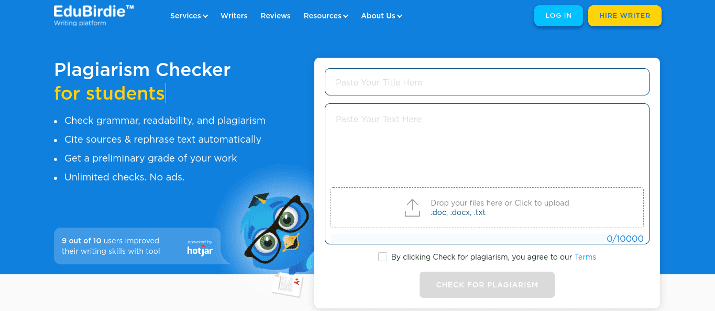
On the flip side, EduBirdie also provides an excellent plagiarism checker. And, unlike Turnitin, it is free to use!
The EduBirdie plagiarism checker will scan a text and assign a similarity score, pointing out instances of plagiarism. Furthermore, it will show you when a source should be cited, and it even has a citation generator that will help students generate citations instantly.
In addition to being a plagiarism checker, EduBirdie can also check your grammar. It can point out grammar mistakes and help you improve your writing style.
It also gives you a readability score, pointing out sentences that are too long, unnecessary phrases, and other wording that make your text too complicated to read.
As a teacher, you don’t have to tell your students about EduBirdie. You can simply use it yourself to look for plagiarism in texts your students submitted – it is free to use.
As a student, you can use PapersOwl to check your writing for grammar and spelling mistakes, look for accidental plagiarism, and generate in-text citations before submitting your assignments. Just don’t use the rephraser tool – it’s important to be unique, as your teacher may be using another plagiarism detector that can pick up on rephrased sentences.
8. Plagly
Plagly is a plagiarism checker that is entirely free to use, for both students and educators, unlike Turnitin. It also has a separate grammar checker.
According to Plagly, the plagiarism checker will search through 20 billion sources for potential matches, including the internet and other databases. However, it is not entirely clear which databases those are.
Nevertheless, Plagly can be a good alternative if you are a student or teacher on a budget and can not afford expensive tools, and your institution does not provide a Turnitin account.
9. Plagium
Another free alternative to Turnitin is Plagium. It will take your text and search for matches across the web.
You can paste content directly into the tool, using the Google Docs add on, or analyze a URL or file.
All searches of up to 1,000 words on Plagium are always free. However, if you would like to scan a document that is over 1,000 words, you will have to purchase credits.
Also, if you want to conduct a Deep Search, you will have to purchase credits. The Deep Search scans are best for longer documents and will bring up more accurate plagiarism results.
Regular searches start at just $0.04/page, while Deep Search scans start at $0.08/page. Bonuses are available for bulk purchases, and monthly plans are available, too.
On the pricing page, you can see updated pricing for different currencies.
Educators can create institutional accounts, which allow them to add users and spread credit availability across all students or users.
Also Read: Best Punctuation Checker Apps
10. Copyleaks
Copyleaks is another good alternative to Turnitin for students and teachers. Unlike Turnitin, it allows you to scan documents for free, but only up to 20 scans a month, thus making the free version better suited for students as opposed to teachers.
According to Copyleaks, it will compare the text you enter to 60 trillion pages on the internet and look for matches.
A cool feature of Copyleaks is that it allows you to take a picture of your written essay (or a student’s written essay) and scan the text in the image for plagiarism. Scanning written essays can be hard, but it’s important, as students can still copy text from the internet and simply write it down.
Wrapping It Up: What Is The Best Turnitin Alternative?
The best Turnitin alternative is Quetext. It provides a way for teachers and students to quickly scan for plagiarism, either for free or on a budget, comparing a document to billions of web pages and academic works.
Quetext is easy to use and has transparent pricing. It checks for missing citations and allows you to add them with ease.

Benjamin Levin is a digital marketing professional with 4+ years of experience with inbound and outbound marketing. He helps small businesses reach their content creation, social media marketing, email marketing, and paid advertising goals. His hobbies include reading and traveling.
